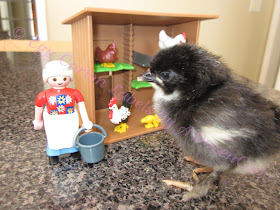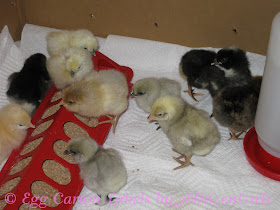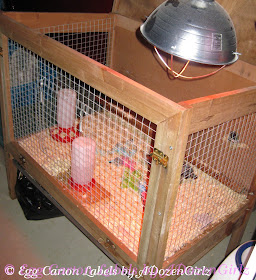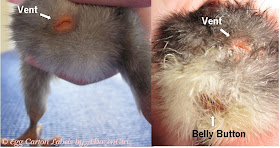Love this Article by:
ADozenGirlz, the Chicken Chick
I was more nervous anticipating my
first chicks' arrival than my first child's birth. I read everything I
could find, only to discover that caring for baby chicks just
isn't complicated. All chicks need to thrive is a caring chicken-keeper
with safe, warm housing, food and clean water. There is no need to
over-think baby chick care.
 |
| Baby chicks grow at an astonishing rate, an important consideration when planning brooder set-up. |
BE PREPARED
It's important to prepare before chicks arrive. Having housing set up and supplies on-hand makes for a stress-free, enjoyable experience for everyone. Their immediate needs will be water and heat (food, a little later).
| Ask the post office to call you as soon as they arrive for immediate pickup. |
| My chicks arrived at 6:00 am and I was there to meet them. |
| Happy, warm newbies do not huddle together. |
All brooders should be capable of being covered to keep chicks inside and unwanted guests (like well-intentioned family pets) out. Even very young chicks can escape from an uncovered brooder. I rest a spare piece of hardware cloth on top of my brooders beginning in week two. While this is adequate to keep chicks in, a more secure method will be needed to keep pets out.
Brooder Size: Plan on 2 square feet per chick, which will seem excessive initially, but they grow at an unbelievable rate . It's important that they have adequate space available to avoid problems that result from overcrowding, such as picking.
Location: The brooder must be in a draft-free location where a heat lamp can be hung safely or an alternative heating device plugged in; ideally the brooder will be located in a room with a window to allow chicks the benefit of natural day/night conditions.
Bedding: Chicks require a flooring surface that is safe for walking on and absorbent. I recommend paper towels over puppy training pad for the first 5-7 days.
 |
| Tiny feet require traction. |
The
puppy pad keeps the brooder protected from inevitable water spills and
the paper towels provide traction for sure-footedness and are absorbent
to wick away moisture from droppings. Paper towels should be changed
frequently. Newspaper should never be used as flooring; it is slippery and can cause spraddle leg.
To
avoid the risk of drowning, it's best to use a commercial waterer versus
a shallow dish. Elevating the waterer will help keep shavings out of it
but chicks always find a way to poop in it, so frequent changing is
necessary.
Feed-
Chicks should have access to starter feed at all times. It is
nutritionally complete and specially prepared to be easily digested
without supplying additional grit.
Medicated
chick starter feed protects chicks from contracting coccidiosis, which
is an intestinal disease, transmitted through droppings that can quickly
kill chicks. Starter feed comes in un-medicated form as well. Some
chicks are innoculated against "cocci" and these chicks should NOT be
fed medicated starter as doing so renders them unprotected from the
disease.
Chicks do
not require access to grit if their diet consists solely of starter
but if they are fed treats, grit is necessary to aid in digestion.

 |
| Check & tighten wing nut often. |
When using
a heat lamp, the brooder should be be kept between 90-95° F . A
thermometer located approximately 2-4 inches from the brooder floor will
indicate whether the lamp needs to be raised or lowered to achieve the
target temperature.
Each week after the first, the temperature should be reduced by five degrees. That's what I call 'The Formula.*"
 |
| Note thermometer on back wall of brooder. |
The Formula
Week 1= 90-95°
Week 2= 85-90°
Week 3= 80-85°
Week 3= 75-80°
Week 4= 70-75° etc
The
Formula is a general guideline, the behavior of chicks is a better
indicator of their true comfort level. Happy chicks are quiet
chicks.Content chicks will be dispersed throughout the brooder, happily
going about their business. When they are too warm, they will pant and
stay far away from the light, when they huddle together or cheep noisily
like the one in this video, they are not warm enough. Simply adjust the lamp in either case.| Cold, unhappy chicks. |
I cannot stress enough that the priority in keeping chicks warm must be safety.
Heat lamp parts can loosen, chicks can fly and knock into them, lamps
can fall, get knocked over and swing into flammable objects. When using a
heat lamp, secure it in several different ways, anticipating the
failure of any one and keep it clear of anything flammable.
Things to Watch Out For and Guard Against
There are two fairly common conditions to be on the lookout for: spraddle leg and pasty butt.
Spraddle leg:
also known as 'splay leg,' is a deformity of the legs, characterized by
feet pointing to the side, instead of forward, making walking
difficult, if not impossible. The most common cause is slippery brooder
flooring. The deformity can be permanent if unaddressed and is easily
fixed, I discuss how to fix spraddle leg here.
 |
| Normal looking vents like these will not have poop caked on them. Belly button area beneath vent may have residual umbilical cord attached & should not be pulled or removed. |
Pasty Butt:
is a condition where loose droppings stick to the down surrounding a
chick's vent, building up to form a blockage that can be fatal unless
removed. Pasty butt can be caused by stress from
shipping, being overheated, too cold or from something they have eaten.
All chicks should be checked for pasty butt upon arrival. If droppinngs
are caked onto the vent area, they can be loosened with a dip in warm
water or a damp washcloth or paper towel and gently removed, being
careful not to pull as the skin can tear. After cleaning and drying the
vent area, the application of petroleum jelly or triple antibiotic
ointment can prevent the droppings from sticking to the down.
If several chicks develop pasty butt after a few days in the brooder, it may be too hot and the temperature should be adjusted.
 |
| Tiny Diva. |
*The truth about The Formula: While 90° heat is critical in the first few weeks of life, but despite The Formula, chicks do not need as much constant heat as a heat lamp provides and are capable of regulating their own body temperatures as seen when raised by a mother hen. See here for more on the subject.
 |
| These chicks were hatched by a mama hen and were contemplating some outside time. |


No comments:
Post a Comment
Do To the enormous amounts of spam I will no longer take the time to moderate Anyone posting under anonymous... Sorry for the inconvenience but my email is blasted everyday with 40 to 50 anonymous posts that are junk mail. I just don't have the time to read each one before deleting.